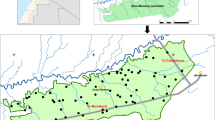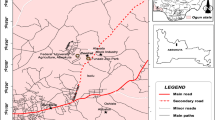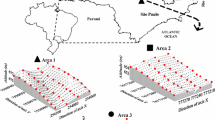Abstract
Data related to physical and chemical properties of paddy soils is necessary for improving rice productivity and designing of sustainable farming techniques and environment protection. In this research, Sefidrood plateaus and upper terraces, river alluvial plain, lowland and Caspian Sea coastal plain landforms in a toposequence were recognized which located in Guilan province of Northern Iran. Five profiles were studied on each landform, which one of them was selected in order to detail study as reference profile. Physical and chemical characteristics were studied by providing disturbed soil samples from the horizons of described soils. Results showed that soil structure was weak granular in all surface horizons and single grain in the subsurface horizons of the Coastal plain. Soil structure was sub-angular blocky and angular blocky in the subsurface horizons of other units. Soil organic matter was high in surface horizons because of accumulation of rice plant residues. Organic matter was the highest level in lowland due to high ground water table and lower decomposition rate. Cation exchange capacity was high in lowland and alluvial plain due to high organic matter and clay content in soils. Clay particles in plateaus lands were lower than other units because of alteration, suitable aeration and occurrence of ferrolysis process. Electrical conductivity was high in subsurface horizons of lowlands and coastal plain because of high ground water table. Exchangeable Na+ was high in subsurface horizons of coastal plain and lowlands due to sea water seepage from depth in these soils. Soil reaction was nearly neutral because of natural and artificial submerged effect. Finally, multivariate analysis of variance (MANOVA) model was performed on soil physical and chemical properties and showed significant difference among landforms. Mean comparison of soil physical and chemical properties using least significant difference test proved significant difference of these properties on soils of studied landforms. Therefore, multivariate statistical analysis i.e. MANOVA model could be applied in exact surveying of paddy soils properties, sustainable land management for agriculture and environment protection.







Similar content being viewed by others
References
Abubakar MS, Ahmad D, Othman J, Sulaiman S (2010) Mechanical properties of paddy soil in relation to high clearance vehicle mobility. Aust J Basic Appl Sci 4(5):906–913
Akef M, Mahmoodi S, Eghbal KM, Sarmadian F (2003) Studying the changes of physicochemical and micromorphological characteristics of soils in converted natural forests to paddy soils in foumanat region in Guilan province. J Iran Nat Resour 56(4):407–423 (in Persian)
Barakat A, Ennaji W, El Jazouli A, Amediaz R, Touhami F (2017) Multivariate analysis and GIS-based soil suitability diagnosis for sustainable intensive agriculture in Beni-Moussa irrigated subperimeter (Tadla plain, Morocco). Model Earth Syst Environ 3:3. https://doi.org/10.1007/s40808-017-0272-5
Bockari M, Ishak W, Azimi Y, Chan C (2004) Effect of rotary tillage on soil physical properties and energy consumption in a Malaysian paddy field. Malays J Soil Sci 8:25–38
Eickhorst T, Tippkotter R (2009) Management-induced structural dynamics in paddy soils of south east China simulated in microcosms. Soil Till Res 102:68–178. https://doi.org/10.1016/j.still.2008.07.007
Goto E, Miura S, Nomura M (2003) The present condition of chemical properties of paddy soils in hokkaido. Jpn J Soil Sci Plant Nutr 74(4):475–483
Hassannezhad H, Pashaee A, Khormali F, Mohammadian M (2008) Morphology and micromorphology of paddy soils under different soil moisture regime and ground water table in mazandaran province, Northern Iran. Amol. Int J Soil Sci 3(3):149–156. https://doi.org/10.3923/ijss.2008.149.156
Huang LM, Thompson A, Zhang GL, Chen LM, Han GZ, Gong ZT (2015) The use of chronosequences in studies of paddy soil evolution: a review. Geoderma 237–238:199–210. https://doi.org/10.1016/j.geoderma.2014.09.007
Kirchhof G, Priyono S, Utomo WH, Adisarwanto T, Dacanay EV, So HB (2000) The effect of soil puddling on the soil physical properties and the growth of rice and post-rice crops. Soil Till Res 56:37–50. https://doi.org/10.1016/S0167-1987(00)00121-5
Kogel-Knabner I, Amelung W, Cao Z, Fiedler S, Frenzel P (2010) Biogeochemistry of paddy soils. Geoderma 157:1–14. https://doi.org/10.1016/j.geoderma.2010.03.009
Kulkarni GE, Muley AA, Deshmukh NK, Bhalchandra U (2018) Multivariate statistical techniques for prediction of tree and shrub species plantation using soil parameters. Model Earth Syst Environ. https://doi.org/10.1007/s40808-017-0408-7
Lee SB, Lee CH, Jung KY, Park KD, Lee D, Kim PJ (2009) Changes of soil organic carbon and its fractions in relation to soil physical properties in a long-term fertilized paddy. Soil Till Res 104:227–232. https://doi.org/10.1016/j.still.2009.02.007
Liu Z, Zhou W, Shen J, He P, Lei Q, Liang G (2014) A simple assessment on spatial variability of rice yield and selected soil chemical properties of paddy fields in South China. Geoderma 235–236:39–47. https://doi.org/10.1016/j.geoderma.2014.06.027
Longford NT (2010) Multivariate analysis of variance. In: Peterson PL, Baker E, MacGaw B (eds) International encyclopedia of education, 3rd edn. Elsevier, Amsterdam, pp 319–323. https://doi.org/10.1016/B978-0-08-044894-7.01349-X
McBratney A, Field DJ, Koch A (2014) The dimensions of soil security. Geoderma 213:203–213. https://doi.org/10.1016/j.geoderma.2013.08.013
McDonald AJ, Riha SJ, Duxbury JM, Steenhuis TS, Lauren JG (2006) Soil physical responses to novel rice cultural practices in the rice wheat system: Comparative evidence from a swelling soil in Nepal. Soil Till Res 86:163–175. https://doi.org/10.1016/j.still.2005.02.005
Minasny B, Hong SY, Hartemink AE, Kim YH, Kang SS (2016) Soil pH increase under paddy in South Korea between 2000 and 2012. Agric Ecosyst Environ 221:205–213. https://doi.org/10.1016/j.agee.2016.01.042
Mousavi SF, Yousefi-Moghadam S, Mostafazadeh-Fard B, Hemmat A, Yazdani MR (2009) Effect of puddling intensity on physical properties of a silty clay soil under laboratory and field conditions. Paddy Water Environ 7(1):45–54. https://doi.org/10.1007/s10333-008-0148-4
Nosrati K (2015) Application of multivariate statistical analysis to incorporate physico-chemical surface water quality in low and high flow hydrology. Model Earth Syst Environ 1:19. https://doi.org/10.1007/s40808-015-0021-6
Pan G, Wu L, Li L, Zhang X, Gong W, Wood Y (2008) Organic carbon stratification and size distribution of three typical paddy soils from Taihu Lake Region, China. J Environ Sci 20(4):456–463. https://doi.org/10.1016/S1001-0742(08)62079-3
Pazand K (2016) Geochemistry and multivariate statistical analysis for fluoride occurrence in groundwater in the Kuhbanan basin, Central Iran. Model Earth Syst Environ 2:72. https://doi.org/10.1007/s40808-016-0127-5
Pedersen O, Colmer TD, Sand-Jensen K (2013) Underwater photosynthesis of submerged plants-recent advances and methods. Front Plant Sci 4:140:1–19. https://doi.org/10.3389/fpls.2013.00140
Ponnamperuma FN (1978) Electrochemical change in submerged soil and the growth of rice. In: Soils and rice. International Rice Research Institute, Los Banos, pp 421–441
Prakongkep N, Suddhiprakarn A, Kheoruenromne I, Gilkes RJ (2007) Micromorphological properties of Thai paddy soils. Kasetsart J Nat Sci 41:42–48
Rezapor S, Jafarzadeh AA, Samadi A, Oustan Sh (2009) Distribution of iron oxides forms on a transect of calcareous soils, north-west of Iran. Arch Agron Soil Sci 56(2):165–182. https://doi.org/10.1080/03650340902956660
Sharma T, Singh O (2017) Soil erosion susceptibility assessment through geo-statistical multivariate approach in Panchkula district of Haryana, India. Model Earth Syst Environ 3(2):733–753. https://doi.org/10.1007/s40808-017-0331-y
Soil Survey Staff (2012) Field book for describing and sampling soils, version 3, National Soil Survey Center, Lincoln
Soil Survey Staff (2014a). Kellogg soil survey laboratory methods manual. Soil survey investigations report no. 42, version 5. In: Burt R, Soil Survey, Staff (eds) United States Department of Agriculture, Natural Resources Conservation Service
Soil Survey Staff (2014b) Keys to Soil Taxonomy. 12th edn., Natural Resources Conservation Service, Washington DC.
SPSS 24 (2016) Statistical analysis software (standard version). SPSS Inc., Chicago
Tang L, Zeng GM, Nourbakhsh F, Shen GL (2009) Artificial neural network approach for predicting cation exchange capacity in soil based on physico-chemical properties. Environ Eng Sci 26:137–146. https://doi.org/10.1089/ees.2007.0238
USDA (2012) Java Newhall (Soil Climate) Simulation Model (jNSM). United State Department of Agriculture, Natural Resources Conservation Service
Wissing L, Kölbl A, Schad P, Bräuer T, Cao ZH, Kögel-Knabner I (2014) Organic carbon accumulation on soilmineral surfaces in paddy soils derived fromtidal wetlands. Geoderma 228–229:90–103. https://doi.org/10.1016/j.geoderma.2013.12.012
ZhangGL,GongZT(2003)Pedogenic evolution of paddy soils indifferent soil landscapes.Geoderma115:15–29.https://doi.org/10.1016/S0016-7061(03)00072-7.
Zhou W, Lv TF, Chen Y, Westby AP, Ren WJ (2014) Soil Physicochemical and Biological Properties of Paddy-Upland Rotation: a Review. Sci World J article ID:856352. https://doi.org/10.1155/2014/856352
Zhou H, Fang H, Mooney SJ, Peng X (2016) Effects of long-term inorganic and organic fertilizations on the soil micro and macro structures of rice paddies. Geoderma 266:66–74. https://doi.org/10.1016/j.geoderma.2015.12.007
Acknowledgements
This project was funded by a grant from the research council of Regional water organization of Guilan province. The authors wish to express their sincere thanks to the Regional water organization of Guilan province for supporting field studies and samplings. The authors are grateful to anonymous reviewers who considerably improved the quality of the manuscript.
Author information
Authors and Affiliations
Corresponding author
Rights and permissions
About this article
Cite this article
Seyedmohammadi, J., Matinfar, H.R. & Esmaeelnejad, L. Multivariate statistical technique for variability analysis of physical and chemical properties along a paddy soils toposequence. Model. Earth Syst. Environ. 4, 777–791 (2018). https://doi.org/10.1007/s40808-018-0450-0
Received:
Accepted:
Published:
Issue Date:
DOI: https://doi.org/10.1007/s40808-018-0450-0




